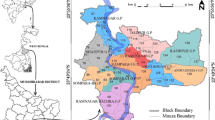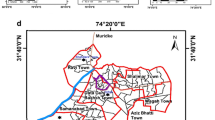Abstract
Groundwater arsenic (As) contamination affects millions of people in South Asia. In this paper, we propose a composite vulnerability framework to identify, for mitigation, the population who are at the highest risk of suffering adverse impacts from exposure to As and warrant mitigation measures. Bihar, India, which was selected for the case study, has large areas with As concentrations far exceeding the upper limits of acceptable level of As in drinking water. Drawing on the existing social science research, we identify a host of socioeconomic and demographic variables, in addition to As concentration in groundwater, which compound a community’s vulnerability to the adverse effects of As. The result is a “composite vulnerability index,” which consists of biophysical, socioeconomic, and demographic factors that collectively determine a community’s overall vulnerability to As. Additionally, using geographic information systems (GIS), we represent the composite vulnerability index visually through a set of maps, which highlight the interaction between different community characteristics to generate unique community vulnerability profiles. In summary, this paper outlines a systematic approach to understanding vulnerability to groundwater As, as both social and natural construct, which can be applied to different geographic areas, and to improving decision making and planning pertaining to diverse environmental problems.











Similar content being viewed by others
References
Adger WN, Brooks N, Bentham G, Agnew M, Eriksen S (2004) New indicators of vulnerability and adaptive capacity. Tyndall Centre for Climate Change Research Norwich
BAMETI (2014) Agriculture profile of the state-Bihar. Bihar Agricultural Management and ExtensionTraining Institute (BAMETI)
Banerjee M, Banerjee N, Bhattacharjee P, Mondal D, Lythgoe PR, Martínez M, Pan J, Polya DA, Giri AK (2013) High arsenic in rice is associated with elevated genotoxic effects in humans. Scientific reports 3
Bates KA, Swan RS (2007) Through the eye of Katrina: social justice in the United States. Carolina Academic Press, Durham
Bihardays T (2011) How girls from arsenic-hit villages can’t get married: along the UP-Bihar border!. Bihardays, Bihar
Birkmann J, Cardona OD, Carreño ML, Barbat AH, Pelling M, Schneiderbauer S, Kienberger S, Keiler M, Alexander D, Zeil P, Welle T (2013) Framing vulnerability, risk and societal responses: the MOVE framework. Nat Hazards 67(2):193–211
BIS (2012) Indian standard DRINKING WATER—SPECIFICATION (second revision): is 10500: 2012, Bureau of Indian Standards, Manak Bhavan, 9 Bahadur Shah Zafar Marg, New Delhi 110002, India
Brinkel J, Khan MH, Kraemer A (2009) A systematic review of arsenic exposure and its social and mental health effects with special reference to Bangladesh. Int J Environ Res Public Health 6(5):1609–1619
BRLPS (2007) Poverty and social assessment: a district wise study of Bihar. Bihar rural livelihood project Bihar rural livelihoods promotion society (BRLPS), State Rural Livelihoods Mission (SRLM), Bihar, India
BSPCB M (2007) State of environment report, Bihar, Bihar State Pollution Control Board, Patna and Ministry of Environment and Forest, Government of Bihar, India
Census (2013) Annual Health Survey 2011–2012 fact sheet, Vital Statistics Division, office of the Registrar General and Census Commissioner, New Delhi, India
Center H (2002) Human links to coastal disasters. The H. John Heinz III Center for Science, Economics and the Environment, Washington, DC
Chakraborti D, Mukherjee SC, Pati S, Sengupta MK, Rahman MM, Chowdhury UK, Lodh D, Chanda CR, Chakraborti AK, Basu GK (2003) Arsenic groundwater contamination in Middle Ganga Plain, Bihar, India: a future danger? Environ Health Perspect 111(9):1194
Chowdhury UK, Biswas BK, Chowdhury TR, Samanta G, Mandal BK, Basu GC, Chanda CR, Lodh D, Saha KC, Mukherjee SK (2000) Groundwater arsenic contamination in Bangladesh and West Bengal, India. Environ Health Perspect 108(5):393
Cord L, Verhoeven M, Blomquist C, Rijkers B (2009) The global economic crisis: assessing vulnerability with a poverty lens. World Bank research note, Washington, DC
Cox J, Rosenzweig C, Solecki W, Goldberg R, Kinney P (2006) Social vulnerability to climate change: a neighborhood analysis of the Northeast US megaregion. Draft white paper for Union of Concerned Scientists, Northeast Climate Change Impact Study. http://www.northeastclimateimpacts.org/pdf/tech/cox_et_al.pdf
Cutter SL, Finch C (2008) Temporal and spatial changes in social vulnerability to natural hazards. Proc Natl Acad Sci 105(7):2301–2306
Cutter SL, Barnes L, Berry M, Burton C, Evans E, Tate E, Webb J (2008) A place-based model for understanding community resilience to natural disasters. Glob Environ Change 18(4):598–606
Cutter SL, Emrich CT, Webb JJ, Morath D (2009) Social vulnerability to climate variability hazards: a review of the literature. Final report to Oxfam America, pp 1–44
Das RJ (1999) Geographical unevenness of India’s green revolution. J Contemp Asia 29(2):167–186
Datta D, Kaul M (1976) Arsenic content of drinking water in villages in Northern India. A concept of arsenicosis
ESRI (2012) ArcGIS for Desktop 10.1, Environmental Systems Research Institute
Ghosh A, Singh S, Bose N, Ramanathan A, Bhattacharya P, Keshari A (2005). Arsenic hot spots detected in the State of Bihar (India) a serious health hazard for estimated human population of 5.5 Lakhs. International Conference on Environmental Management, Hyderabad, India
Ghosh A, Singh S, Bose N, Chowdhary S (2007) Arsenic contaminated aquifers: a study of the Ganga levee zone in Bihar, India. Symposium on Arsenic: The Geography of a Global Problem, Royal Geographical Society, London. http://www.geog.cam.ac.uk/research/projects/arsenic
Ghosh AK, Singh SK, Singh SK, Singh A, Roy N, Upadhyaya A, Bose N, Chaudhary S, Mishra R (2008) Study of arsenic contamination in ground water of Bihar, (India) along the river ganges. Water Energy Abstr 18(1):19–20
GSI (2012) Geology and mineral resources of eastern region. Geological Survey of India (GSI), Kolkata, India
Guha Mazumder D, Dasgupta U (2011) Chronic arsenic toxicity: studies in West Bengal, India. Kaohsiung J Med Sci 27(9):360–370
Guillard-Gonçalves C, Cutter SL, Emrich CT, Zêzere JL (2014) Application of social vulnerability index (SoVI) and delineation of natural risk zones in Greater Lisbon, Portugal. J Risk Res. doi:10.1080/13669877.2014.910689
Hossain MA, Mukharjee A, Sengupta MK, Ahamed S, Das B, Nayak B, Pal A, Rahman MM, Chakraborti D (2006) Million dollar arsenic removal plants in West Bengal, India: useful or not? Water Qual Res J Can 41(2):216–225
IPCC (2007) Assessing key vulnerabilities and the risk from climate change. In: Parry ML, Canziani OF, Palutikof JP, van der Linden PJ, Hanson CE (eds) Climate change 2007: impacts, adaptation and vulnerability, contribution of working group II to the fourth assessment report of the intergovernmental panel on climate change. Cambridge University Press, Cambridge, pp 7–72
Kienberger S, Lang S, Zeil P (2009) Spatial vulnerability units–expert-based spatial modelling of socio-economic vulnerability in the Salzach catchment, Austria. Nat Hazards Earth Syst Sci 9(3)
Lado LR, Polya D, Winkel L, Berg M, Hegan A (2008) Modelling arsenic hazard in Cambodia: a geostatistical approach using ancillary data. Appl Geochem 23(11):3010–3018
Mandal BK, Suzuki KT (2002) Arsenic round the world: a review. Talanta 58(1):201–235
Mazumder DNG, Ghosh A, Majumdar KK, Ghosh N, Saha C, Mazumder RNG (2010) Arsenic contamination of ground water and its health impact on population of district of Nadia, West Bengal, India. Indian J Commun Med 35(2):331
Mukherjee A, Sengupta MK, Hossain MA, Ahamed S, Das B, Nayak B, Lodh D, Rahman MM, Chakraborti D (2006) Arsenic contamination in groundwater: a global perspective with emphasis on the Asian scenario. J Health Popul Nutr 24(2):142–163
Mukherjee A, Scanlon BR, Fryar AE, Saha D, Ghosh A, Chowdhuri S, Mishra R (2012) Solute chemistry and arsenic fate in aquifers between the Himalayan foothills and Indian craton (including central Gangetic plain): Influence of geology and geomorphology. Geochim Cosmochim Acta 90:283–302
Nickson R, Sengupta C, Mitra P, Dave S, Banerjee A, Bhattacharya A, Basu S, Kakoti N, Moorthy N, Wasuja M (2007) Current knowledge on the distribution of arsenic in groundwater in five states of India. J Environ Sci Health Part A 42(12):1707–1718
Nordstrom DK (2002) Worldwide occurrences of arsenic in ground water. Science (Washington) 296(5576):2143–2145
Papathoma-Köhle M, Kappes M, Keiler M, Glade T (2011) Physical vulnerability assessment for alpine hazards: state of the art and future needs. Nat Hazards 58(2):645–680
Parry ML (2007) Climate change 2007: impacts, adaptation and vulnerability: contribution of Working Group II to the fourth assessment report of the intergovernmental panel on climate change. Cambridge University Press, Cambridge
Phillips B, Fordham M (2009) Introduction: chapter 1. Social vulnerability to disasters. CRC Press, Boca Raton
Rahman MM, Mondal D, Das B, Sengupta MK, Ahamed S, Hossain MA, Samal AC, Saha KC, Mukherjee SC, Dutta RN (2013) Status of groundwater arsenic contamination in all 17 blocks of Nadia district in the state of West Bengal, India: A 23-year study report. J Hydrol. doi:10.1016/j.jhydrol.2013.10.037
Ravenscroft P, Brammer H, Richards K (2011) Arsenic pollution: a global synthesis. Wiley, New York
Saha D (2009) Arsenic groundwater contamination in parts of middle Ganga plain, Bihar. Curr Sci 97(6):753–755
Saha D, Shukla R (2013) Genesis of Arsenic-Rich Groundwater and the Search for Alternative Safe Aquifers in the Gangetic Plain, India. Water Environ Res 85(12):2254–2264
Saha D, Dhar Y, Sikdar P (2008) Geochemical evolution of groundwater in the Pleistocene aquifers of south Ganga plain, Bihar. J Geol Soc India 71(4):473
Saha D, Dwivedi S, Sahu S (2009) Arsenic in ground water in parts of middle ganga plain in Bihar-an appraisal. Editor Board 24(2&3):82–94
Saha D, Sarangam SS, Dwivedi SN, Bhartariya KG (2010) Evaluation of hydrogeochemical processes in arsenic-contaminated alluvial aquifers in parts of Mid-Ganga Basin, Bihar, Eastern India. Environ Earth Sci 61(4):799–811
Saha D, Sahu S, Chandra P (2011) Arsenic-safe alternate aquifers and their hydraulic characteristics in contaminated areas of Middle Ganga Plain, Eastern India. Environ Monit Assess 175(1–4):331–348
Schmidtlein MC, Deutsch RC, Piegorsch WW, Cutter SL (2008) A sensitivity analysis of the social vulnerability index. Risk Anal 28(4):1099–1114
Singh S (2011) Arsenic contamination in water, soil, and food materials in Bihar. LAP LAMBERT Academic Publishing, Germany
Singh SK, Ghosh AK (2012) Health risk assessment due to groundwater arsenic contamination: children are at high risk. Human Ecol Risk Assess Int J 18(4):751–766
Singh KM, Jha A (2012) Innovative approaches in technology dissemination: experiences of ATMA model in Bihar. Available at SSRN 2168646
Singh S, Ghosh A, Kumar A, Kislay K, Kumar C, Tiwari R, Parwez R, Kumar N, Imam M (2014) Groundwater arsenic contamination and associated health risks in Bihar, India. Int J Environ Res 8(1):49–60
SOES (2006) Groundwater arsenic contamination in West Bengal, India (20 years study). Retrieved June 6, 2014, from http://www.soesju.org/arsenic/wb.htm
SPSS I (2012) IBM SPSS statistics version 21. International Business Machines Corp, Boston, Mass
Tierney KJ (2001) Facing hazards and disasters: understanding human dimensions. National Academy Press, Washington, DC
Tierney KJ, Lindell MK, Perry RW (2001) Facing the unexpected: disaster preparedness and response in the United States, Joseph Henry Press, Washington, DC
UNEP (2003) Assessing human vulnerability due to environmental change: concepts, issues, methods and case studies, United Nations Environment Program (UNEP)
Warner RM (2012) Applied statistics: from bivariate through multivariate techniques: from bivariate through multivariate techniques, Sage
WHO (2004) Guidelines for drinking water quality. 1, Recommendations
Winkel L, Berg M, Amini M, Hug SJ, Johnson CA (2008) Predicting groundwater arsenic contamination in Southeast Asia from surface parameters. Nat Geosci 1(8):536–542
Wisner B (2004) At risk: natural hazards, people’s vulnerability and disasters. Psychology Press, New York
Acknowledgments
The authors would like to thank Dr. Amy V. Ferdinand, Director, Environmental Health and Safety and Ms. Rocio Duchesne, Department of Earth and Environmental Studies, Montclair State University, for their support in GIS mapping. The authors also extend their gratitude to the three anonymous reviewers for their constructive feedback, which helped to significantly improve the quality of this manuscript.
Author information
Authors and Affiliations
Corresponding author
Rights and permissions
About this article
Cite this article
Singh, S.K., Vedwan, N. Mapping composite vulnerability to groundwater arsenic contamination: an analytical framework and a case study in India. Nat Hazards 75, 1883–1908 (2015). https://doi.org/10.1007/s11069-014-1402-2
Received:
Accepted:
Published:
Issue Date:
DOI: https://doi.org/10.1007/s11069-014-1402-2





